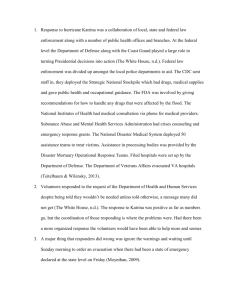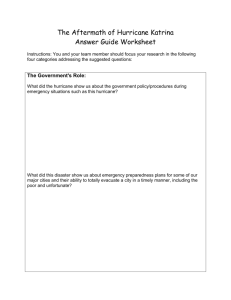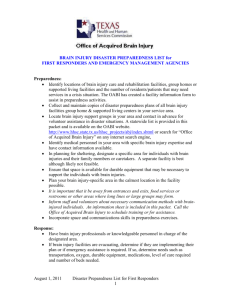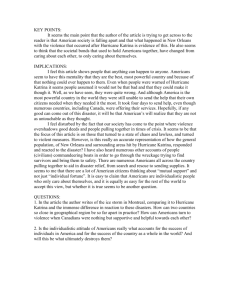2 BEYOND KATRINA Arnold M. Howitt Herman B. “Dutch” Leonard
advertisement
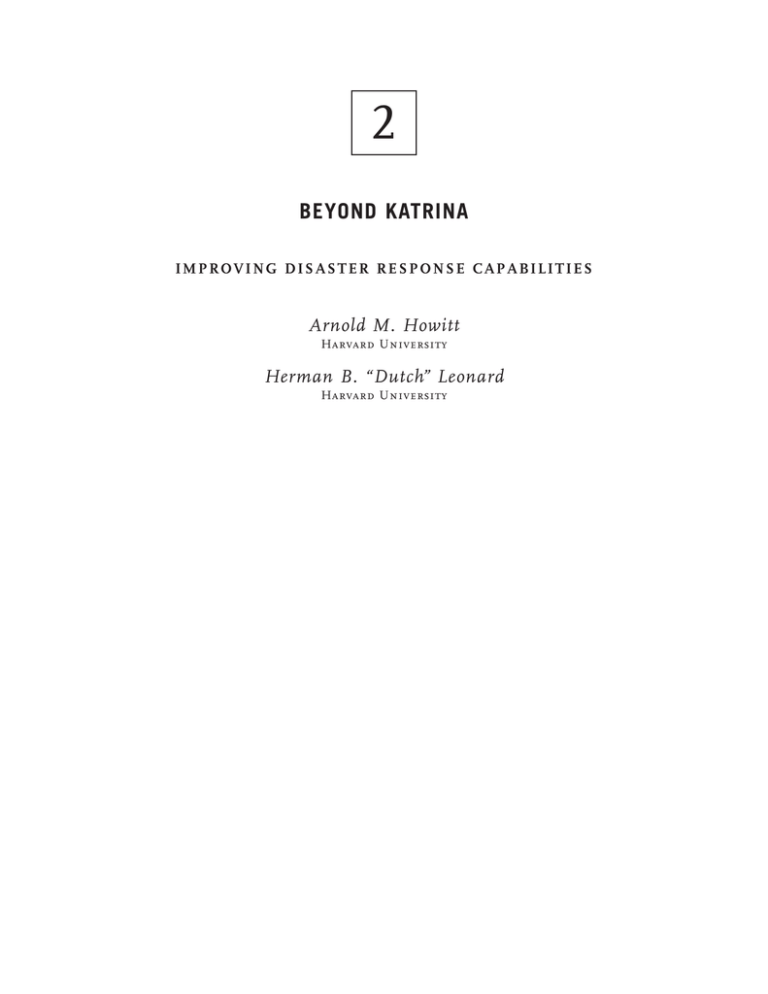
2 BEYOND KATRINA IMPROVING DISASTER RESPONSE CAPABILITIES Arnold M. Howitt Harvard University Herman B. “Dutch” Leonard Harvard University As Hurricanes Katrina, Rita, and Wilma successively lashed the Gulf Coast starting in late August 2005, nature’s fury exposed serious weaknesses in the United States’s emergency response capabilities. These problems were not simply the failure of particular places or leaders to be ready for disaster but rather an indication of more fundamental issues. These must be addressed if the country is to be ready for serious challenges that may lay ahead, whether severe natural disasters, outbreaks of emergent infectious disease, or renewed terrorist attacks. Not all emergencies pose this magnitude of challenge. In the United States, the initial—and usually major—responsibility for disaster response rests with local authorities. This “bottom-up” system of emergency management has a long history and continues to make sense in most circumstances. Because local governments are proximate to disaster sites and have at least some emergency capacity, they can respond quickly to initial alerts. They have detailed knowledge of local conditions, and in many cases have agreements for mutual aid to secure additional help rapidly from nearby jurisdictions. WORKING PAPERS CENTER FOR PUBLIC LEADERSHIP Aid from state or national sources is provided mainly when local capability is inadequate or has been exhausted. State government may have important specialized resources and capabilities, but—farther away—it is usually less able to respond immediately. Its resources may have to travel considerable distance to get to a disaster site. Federal government responders are likely to be even more distant—hence much slower to arrive on a significant scale—and lack both local knowledge and integration with local and state responders. The Federal Emergency Management Agency (FEMA), with relatively few deployable staff, has historically played a much larger role in preevent planning and postevent recovery than in the management of a disaster in progress. Other federal agencies have more operational resources but are generally deployed as backup. Notwithstanding the reorganization of emergency response at the federal level as a consequence of the establishment of the Department of Homeland Security, the “bottomup” system remains the “normal” model of disaster response. 18 Quite clearly, however, the normal model was inadequate to handle the results of Katrina—and showed weakness in managing the fierce but less demanding challenges of Rita and Wilma. Commentators have cited many reasons for this problematic performance. Some have pointed to decisions made decades ago: to build a city in harm’s way and fail to upgrade and sustain investments in protective infrastructure. Others decry the quality of advance preparation: inadequate emergency plans, insufficient training of responders, poor follow-up to shortcomings revealed by tabletop exercises, and failure to build operational systems to coordinate agencies, jurisdictions, and levels of government. Still other criticisms relate to actions just before or in the moment of crisis: weak leadership by elected executives, unqualified crisis managers in charge, failure promptly to mobilize responders or commence evacuation, failure by response organizations to perform effectively. Commentators also point to the contemporary context of national preparedness: overemphasis on terrorism rather than all hazards emergency management, as well as organizational subordination of FEMA inside the new Department of Homeland Security. Although each of these explanations has some merit, in looking closely at emergency response, we see an overarching failure to recognize and prepare for the imperatives of a major disaster. If the United States doesn’t specify the strategic problems properly, efforts to reform the emergency response system are likely to fall short in the next situation that strains the normal model. We see a number of core challenges to which disaster preparedness must accord careful attention. CORE CHALLENGES FOR LARGE-SCALE DISASTER RESPONSE Recognizing Novelty and Effectively Improvising Necessary Responses Katrina was not just “another” hurricane. Emergency responders ready themselves for a wide range of urgent circumstances, including hurricanes. These involve high stakes, danger, and outcomes that are critically contingent on responders’ own effective action. Though quite demanding, many of these situations can be regarded as “routine” emergencies—not because they are in some sense “easy” but because the predictability of the general type of situation permits agencies to prepare in advance and take advantage of lessons from prior experience. Such anticipatable events are “routine” emergencies for both the agencies and individuals concerned. Response organizations develop contingency plans, train personnel, practice their skills, and ready or stockpile necessary resources. In a fast moving routine emergency, individual responders rely on near instantaneous recognition of complex patterns to size up cause and effect and trigger swift implementation of the appropriate protective measures. When forecasters predict that hurricane winds will make land fall, emergency organizations launch a range of programmed actions to protect property, provide temporary shelter and supplies, make rescues as needed, and provide emergency medical care and other assistance. The capacity to treat a wide range of contingencies, including quite severe ones, as “routine” constitutes an enormous source of strength for emergency response personnel and organizations. They have thought through how to act. They are equipped. They have trained and practiced. Their leaders’ judgment has been honed by experience. In moments when delay may literally make a difference of life or death, they don’t need to size up the situation for an extended period, plan their response from scratch, assemble people and resources, and divide up roles and responsibilities. Responders are “ready” in multiple dimensions of the term. But not all emergencies fit the mold. By contrast with “routine” emergencies, therefore, “crises” require quite different capabilities. In crises, responders must first quickly diagnose the elements of novelty (e.g., in New Orleans, the widespread need for assisted evacuation, the likely consequences when the levees failed, and the unexpected use of the convention center for sheltering immobile refugees). Then they need to improvise response measures adequate to cope with the unanticipated dimensions of the emergency (e.g., quickly procuring vehicles for B E Y O N D K AT R I N A “Crises” like Katrina are distinguished from more common “Because of the novelty of a crisis, (though possibly very severe) routine emergencies by significant elements of novelty. These novel features may result from predetermined emergency plans threats never before encountered (e.g., an earthquake in an area and response behavior that may that has not experienced one in recent memory or an emergent infectious disease like SARS or avian flu); or from a more familfunction quite well in dealing with iar event occurring at an unprecedented scale, outstripping available resources; or from a confluence of forces, which, though not routine emergencies are frequently new, in combination pose unique challenges. Katrina was a crisis primarily because of its scale and the mixture of challenges grossly inadequate or even that it posed, not least the failure of the levees in New Orleans. Because of the novelty of a crisis, predetermined emergency counterproductive.” plans and response behavior that may function quite well in dealing with routine emergencies are frequently grossly inadequate or even counterproductive. That proved true in New Orleans, for example, in terms of evacuation planning, law enforcement, rescue activities, sheltering, and provisions for the elderly and infirm. 19 evacuation, making emergency repairs to the levees, and providing food and law and order in an unprepared shelter). These measures, born of necessity, may be quite different from or exceed in scale anything responders have done before. They must be creative and extremely adaptable to execute improvised tactics. Equipping organizations to recognize the novelty in a crisis and improvise skillfully is thus a far different (and far more difficult) matter from preparing mainly to implement preset emergency plans. Scalability and Surge Capacity In many disasters, as Katrina well illustrated, responders must cope with far greater numbers of endangered people or more extensive damage than typical of a routine emergency. Crisis impacts may occur very intensively in a delimited area or be spread across a wide geographic region. To scale up operations to handle this surge of demand, emergency agencies require access to resources in larger quantities than normal and frequently to specialized equipment or personnel. If an emergency lasts for days or weeks, there must be enough people and resources to cope with exhaustion. No local jurisdiction—or even state—could bear the expense of keeping these assets in reserve for a largescale disaster that might never occur there. When such an event strikes, therefore, it is virtually inevitable that the jurisdictions affected will have to import and effectively absorb support from surrounding areas or—in very severe circumstances such as Katrina—from around the nation. WORKING PAPERS CENTER FOR PUBLIC LEADERSHIP In firefighting, most jurisdictions already have mutual aid agreements with neighboring communities that enable any of them to expand available manpower and equipment. In case of a major fire, each community can draw on its neighbors’ resources; so no community has to invest in firefighting capacity sufficient to counter a worst-case scenario. Highly specialized resources may be maintained on a regional or state basis. Mutual aid agreements are regularly invoked, and firefighters from different locales both exercise together and gain experience in confronting real fires. 20 As Katrina revealed, however, it is a far more complex matter to address the need for reserve or “surge” capacity in largescale disasters, in which many kinds of emergency response functions, equipment, and personnel must be mobilized. There are political dimensions to the problem as well. By definition, surge capacity is likely to be unused most of the time. Difficult tradeoffs must be made between local (and thus more rapid) availability of resources and the high costs of sustaining them when no emergency is visible on the horizon. What some see as a “strategic reserve,” others regard as “waste.” Maintaining sufficient capacity to respond to large-scale disasters requires maintaining political support for emergency preparedness budgets, notwithstanding competing, often compelling demands for funds from stakeholders concerned with quite different issues. In the American federal system, moreover, debate about how much responsibility and burden should be assumed by each level of government is also likely to be endemic. The sudden need for many vehicles to evacuate autoless, elderly, or handicapped people from New Orleans indicates the critical need for the right kind of resources, in sufficient amount, to be available in timely fashion. Some of these resources can be provided for in advance. Improved plans can and should be put in place to provide surge capacity for transport, food and water, medical facilities, and personnel. The task requires careful advance assessment of potential needs, detailed logistical planning for transporting resources to disaster sites (or people away from disasters to shelter and care), and procedures for operational integration of personnel and materiel from many sources. Given the cost of acquiring and maintaining this capacity, different levels of government must work out in advance how the emergency plans of each align to provide for sudden surges in demand for response and relief capacity. In effect, they will be moving a potential element of crisis “novelty” into the realm of “routine” preparedness. Whether or not the emergency plans of local, state, or federal response agencies are adequate for even severe routine emergencies, however, the novel circumstances of a crisis may also generate unexpected demands for resources (or predictable demands for which supply remains inadequate) for which improvised scale-up is essential. That involves a further set of considerations. Maintaining Situational Awareness In any crisis, responders (both individuals and organizations) must maintain “situational awareness.” That is, they need to gather and assimilate key facts—often under conditions of great confusion and uncertainty—and assess how they are positioned to deal with the emergency. The response to Katrina reflects numerous examples of situational unawareness: failure to expedite the evacuation of New Orleans sufficiently in advance of the storm, failure to anticipate the substantial number of individuals who could not self-evacuate because they lacked cars and access to transit or were confused or too physically infirm to manage, slow or inadequate response to the breach of the levees, and lack of awareness of the conditions faced by people sheltered in the New Orleans Convention Center. Press and official comment has focused on whether or not key officials received or reached out for timely and sufficient information about these conditions. Who knew what—and when—about the developing crisis? As important as good intelligence about an emergency is, however, robust situational awareness involves far more. Decision makers must also be able to project forward the implications of the information they have gathered, so they can anticipate the likely consequences of a stillmoving situation. With anticipation comes at least some possibility of changing the future before it arrives. Projecting likely consequences also provides responders with a way of tracking what actually results against what they expected, thus providing a check on how well they understand what is truly happening. Finally, situational awareness involves being able to generate possible alternative courses of action and assess which holds the most promise of dealing with emergency conditions. As more accounts of decision making during Katrina become part of the public record, it becomes apparent that major shortcomings of situational awareness resulted less because information about conditions was unavailable or that it did not reach senior officials. Instead, leaders failed to project the likely consequences of the developing situation or generate feasible measures to counter the impacts of the storm and levee failure—thus falling short in different dimensions of situational awareness. Integrated Execution in Real Time This need has been recognized by Congress in the 2002 statutory requirement for a National Incident Management System (NIMS), a flexible template for leading crisis operations which enables organizations to frame and rapidly implement response actions under enormous pressure. The underlying model for NIMS (called the Incident Command or Incident Management System, ICS or IMS) was initially devised 35 years ago in California to fight wildland fires and has since spread to many other states and some other emergency professions. In response to the Congressional requirement, the Department of B E Y O N D K AT R I N A In a major disaster, as local agencies confront extraordinary operational demands, emergency responders from adjoining jurisdictions, the state, and farflung locations are likely to converge on the scene. Many will be self-dispatched rather than answering requests for assistance. Not only must they perform useful tasks themselves, they must also collaborate to ensure effectiveness and avoid interference, conflict, or endangerment of others. This demands skillful coordination of aid workers, equipment, and organizations across professions, agencies, jurisdictions, levels of government, and the public and private sectors—even though many of these people and organizations have had little or no prior experience working together. 21 Homeland Security has initiated a staged deployment of NIMS, aiming at full utilization by all emergency response organizations, across professional disciplines and levels of government. IMS has important strengths in organizing emergency response. It factors critical emergency tasks, establishing a clear division of labor and assignment of functional responsibility. It unambiguously defines the chain-of-command, provides a manageable span of control for each function, and establishes a resource allocation decision-making structure—critically important to avoid dispute about “who’s in charge” and to enable rapid deployment and direction of personnel and equipment. It systematically promotes information flows up, down, and across the organization—and to the public. As a result, IMS is highly flexible in response to incident type, scale, and location. It has been applied to wildland and urban fires, industrial explosions, earthquake response, hospital emergency room operations, and hostage scenarios. However, as Katrina revealed, even basic diffusion of NIMS has not been completed in many jurisdictions that have not previously used the system or to professional disciplines that have been unaware or unenthusiastic. Nor were the procedures for federal operations, on one hand, and intergovernmental collaboration, on the other, that were nominally in place adequate or effectively applied to coordinate federal agencies with each other or with state and local responders. Conceptually, the NIMS model has not been fully integrated in the National Response Plan with the structure of the Emergency Support Functions that are the core organizing principle of federal participation in disaster response. These gaps in conception, adoption, and implementation must be addressed in expedited fashion if the potential benefits of NIMS are to be realized. WORKING PAPERS CENTER FOR PUBLIC LEADERSHIP Operational vs. Political Leadership 22 Widespread deployment and skillful use of NIMS is a necessary but not sufficient condition for integrated crisis response. IMS has proved a highly effective technical system when the goals to achieve are relatively unambiguous. For example, in dealing with the typical urban structural fire—even a very severe one—there is generally firm consensus on the priorities and constraints of action: save lives, protect property, but don’t unduly risk the lives of responders. This agreement enables firefighting professionals, clear about the ends they are seeking, to focus mainly on the means they will use. IMS functions best when it is directed at a well defined, reasonably consistent, or clearly prioritized set of purposes. By contrast, where goals are unclear or in conflict—when difficult, controversial trade-offs must be made—IMS lacks the political and moral authority to make the hard choices that present themselves. Even in the fire service, IMS has worked less well when there has been contention about either the goals of response or priorities among several objectives. When a dozen major forest fires menaced southern California in the autumn of 2003, the strategy developed by professional firefighting organizations was subjected to severe criticism by local, state, and federal elected officials who disagreed with both the professionals and each other about the objectives and technical means of fighting the fires. There was no adequate institutional forum in which these elected officials could engage the issues, with each other and the firefighting professionals, so they could be resolved. The emergency response nearly faltered because of this discord. If a pandemic flu, bio-terrorist attack, or nuclear plant disaster occurred, do the responders in command of NIMS—whether police commanders, fire chiefs, or public health directors—have legitimate authority to decide which areas should get resources and which not, perhaps even to make choices that in effect determine who will live and who will die? Do they have the community standing and ability to mobilize public support behind a difficult decision? Can they—should they—hold to their decisions if elected lead-ers challenge them? We invest elected leaders with the authority to make key decisions about values and priorities for society and to rally their communities behind their choices, much as President Bush and New York’s Mayor Giuliani did in the 9/11 crisis. But in a future emergency that cuts across organizational, jurisdictional, and level of government boundaries—particularly if government has been partially disabled by the crisis as it was during and after Katrina—it may be unclear who has this authority and difficult to assemble them in the heat of the moment. It is precisely for such complex situations that NIMS is designed, but the model does not include an effective way to coordinate political leaders and operational commanders, especially when multiple jurisdictions are involved. So, as NIMS develops as an emergency response system, we must create parallel structures for making critical decisions that the public will regard as legitimate and compelling. The temporary emergency operations structure of NIMS must be paired with institutions that do have ready connections to key stakeholders and legitimate decisionmaking authority. The United States has not yet confronted this need, let alone fully thought it through and invented the emergency policy making institutions it requires. That is a step that must still be taken. Handoffs Across Boundaries As action in a crisis scales up and becomes more complex, leadership or certain responsibilities may need to be transferred from those initially in charge to others with different skills or broader authority and resources. Yet frequently this evolution of crisis response produces substantial friction between organizations or jurisdictions, even when emergency plans or statutes theoretically provide for such transitions. During Katrina, these frictions “ In the midst of crisis, the became readily apparent as the city and mayor clashed with the state and leaders of individual agencies governor, as both criticized the federal response, and, ultimately, as voices in other agencies within the federal government criticized FEMA’s or political jurisdictions may performance in leading the federal response. find it personally or politically difficult to recognize or acknowledge that exigent events surpass their ability to cope with the crisis.” While no advance preparation can fully mitigate such reactions, addressing the possibilities inherent in disaster scenarios can reduce the chances of hesitation or paralysis in crisis. Institutionally, within jurisdictions and across levels of government, senior officials should address the conditions and procedures under which handoffs would be made. Key officials must also consider their personal as well as institutional preparedness. Preparedness requires anticipation of the potential need for such handoffs and readiness to make (or accept) transfers of responsibility when the initial allocation is unworkable in the face of a particular disaster. Newly elected or appointed officials need to think through their substantive functions and moral responsibilities as crisis leaders in advance, rather than addressing their obligations for the first time in the midst of catastrophe. B E Y O N D K AT R I N A The mere existence of laws, emergency plans, or NIMS does not ensure that responsible officials will know or play their roles effectively or that conflicts will not arise in interpreting the rules. In the midst of crisis, the leaders of individual agencies or political jurisdictions may find it personally or politically difficult to recognize or acknowledge that exigent events surpass their ability to cope with the crisis; they may, in fact, resist turning full or partial responsibility over to others better situated to deal with circumstances. 23 IMPROVING DISASTER RESPONSE Katrina has shown that the United States has not progressed as far as some believed in building better emergency response capacity in the aftermath of 9/11 and the establishment of the Department of Homeland Security. Addressing the core strategic problems identified above means moving forward effectively in four realms: capabilities, structures and systems, people, and coordination. Capabilities. Successful disaster response critically depends on sufficient equipment, supplies, transportation, and trained responders with the capacity to sustain themselves in the field for the necessary length of time. Because many of these resources are expensive and unlikely to be used most of the time, it would be highly inefficient to maintain them in every location where they might potentially be needed. However, even though there are ways in which the quantity, quality, and types of resources available in the United States for emergency response could be improved, lack of resources is not the principal constraint on more effective response. The main challenge, particularly to provide adequately for surge capacity, lies in being able to locate, mobilize, and move resources swiftly–and to coordinate their use effectively upon arrival at a disaster scene. WORKING PAPERS CENTER FOR PUBLIC LEADERSHIP Structures and Systems. Making the National Incident Management System truly operational at the local and state levels, as well as clarifying and effectively integrating it with the National Response Plan at the federal level, as discussed above, is a critical step. It is essential if the country is to develop scalable emergency response capability that has the flexibility to respond to a wide range of potential threat types and disasters. At all levels of government, moreover, it is important to develop enhanced mutual aid agreements that authorize and make operational a wider range of cooperative arrangements between communities, states, and within regions for all emergency response functions. Both NIMS and mutual aid agreements must not be mere “paper” arrangements, moreover, but “live” procedures against which personnel are trained, exercises are conducted, and routine implementation, to the greatest extent possible, serves to test procedures operationally. 24 People. Both first responders and emergency managers throughout the emergency response system have a general need for increased training and exercising, a need that has begun to be filled in the post-9/11 period but which requires strengthening and sustained commitment. Training and exercises need to be conducted not only for traditional forms of emergencies but also for new contingencies, such as terrorism and emergent infectious disease, that were not seriously on the preparedness agenda a few years ago. This training must be regular and varied, to keep skills sharp and to prepare new members of these professions for the threats they may encounter. In addition, there is a need to develop a cadre of senior disaster managers—in cities, states, and at the federal level—who develop proficiency and deep experience in managing emergencies. It is particularly important that they get experience in dealing with situations that cut across emergency response professions, agencies, jurisdictions, and levels of government. Two significant things would be accomplished if a cadre of emergency leaders were systematically trained and exposed to increasing levels of responsibility in emergency response. Individuals would become more skillful in handling severe challenges. Even more important, the most able among them could be identified, promoted, and deployed to face the most demanding circumstances of natural and technology disasters, emergent infectious disease, or terrorism that the nation might encounter. Coordination. Individual response organizations in many locales are fully capable of dealing with the routine emergencies that they most frequently faced. As Katrina demonstrated, however, crises demand levels of coordination of governmental and non-governmental resources, including many that are not part of the normal configuration of emergency agencies, which the response system is not currently able to provide. The American federal system does not centralize command in the hands of a single entity. As a result, crisis coordination inevitably depends heavily on voluntary collaboration across agencies, jurisdictions, levels of governments, and between the public and private sectors. One key is to develop an “infrastructure” of coordination in advance—by laying out ground rules, establishing protocols about how information will be shared and decisions made, promulgated, and implemented. The NIMS system is an important step in that direction, as is the deepening web of mutual aid agreements among jurisdictions. A second key is to make sure that the formal infrastructure is given life by exercising it regularly—through simulated and real action—and by building personal relationships among the people who will be involved. Both practice and relationship formation are crucial. The task of collaboration, as argued above, has both a technical and political component—which necessitates construction of an infrastructure of coordination along both dimensions. NIMS significantly advances the technical coordination task, but it provides little structure for the political coordination function, which is likely to be at least equally important in crisis situations. That political infrastructure must be developed within metropolitan areas, within and among states, and between states and the federal government—and leaders must not be satisfied with paper procedures that may fail in time of need because of inexperience. The tasks identified here face serious obstacles more complex than can be addressed here. These include the division of authority in the American federal system of government, conflicting constellations of stakeholders at different levels of government and within jurisdictions, “feast or famine” budgeting for emergency preparedness, the independence or near autonomy of different functional or policy domains, and insufficient integration of the private sector in the emergency response system. As the response to Katrina revealed, however, the costs of failing to act in time are real and great. Note B E Y O N D K AT R I N A Brief parts of this paper were previously published in the Fletcher Forum of World Affairs, Vol. 30, No. 1 (Winter 2006): 215-221; and in the Crisis/Response Journal, Vol. 1, No. 2 (Spring 2005): 40-42. 25

